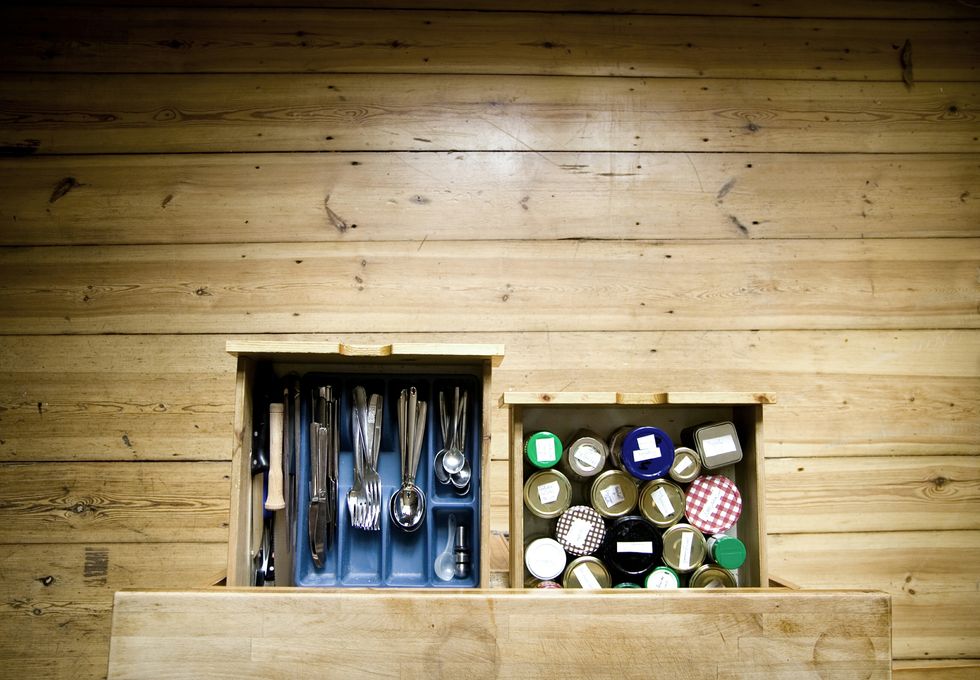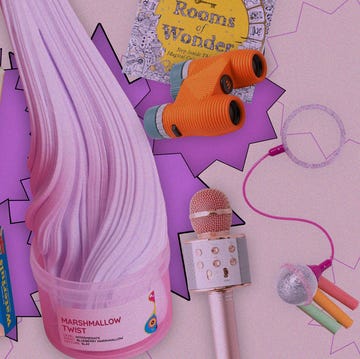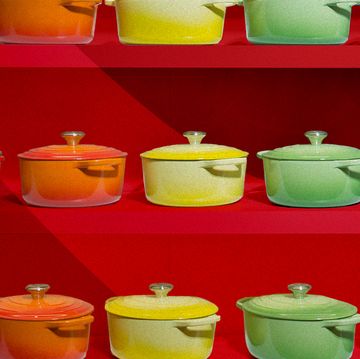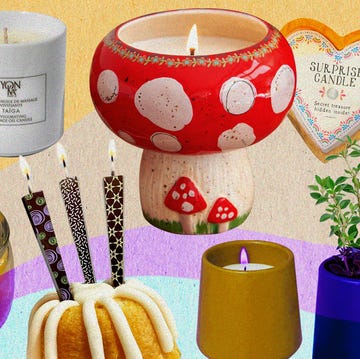It’s spring-cleaning season, which means it’s time to have an honest conversation about what you need and don’t need, especially as we venture more back out into the world. Be honest. Sometimes asking yourself, “When was the last time I wore this piece of clothing?” or “Does this item make me happy?” just doesn’t cut it, especially for those who find absolutely any reason to keep clothing that they might need — later on, of course.
If you’re lousy at decluttering, there’s a good chance it’s because you’re focusing more on what specific material items you’re losing — a purse your grandmother once owned, a shirt you paid way too much for, or that ice cream maker you only used once last summer — rather than looking at the big picture.
“We’re so focused on the negative, but what can you gain?” says Sandy Park, the founder of Tidy With Spark and a KonMari-certified professional home organizer. “It’s more time, freedom, space, and clarity. The list of what you can gain is so much bigger. It’s not what you can gain in stuff; it’s bigger [in] concepts and values.” Park points out that decluttering brings mental clarity and the ability to allow “your mind and your eyes [to] really glide over your space instead of bouncing from item to item.”
Decluttering not only makes your home look as good as new, but it also contributes to lower stress levels. A 2016 study in the Journal of Environmental Psychology found that clutter has a strong negative impact on psychological well-being, while a study from 2009 specifically found that women with cluttered homes were more depressed over the course of the day than those who found their space more restorative.
“Some people say, ‘But I can function in a cluttered space. I can thrive in a space that’s not organized.’ [But] our minds are having to work so much harder,” says Marie Mandeville, the founder of Tailor My Space and a professional organizer based in Atlanta. She points out that organizing provides you with more time for what you actually want to be doing, and decluttering also saves you money. It’s an investment in the future of your space. “You’re not buying things [you already own],” Mandeville says, “over and over again.”
The good news is you don’t have to go through your entire home in a day; you can split up the task across days, weeks, or months. Park recommends starting in the room with the least volume or where you have the least attachment to the items within it. “It’s not going to be [as] emotionally draining,” she says. You can make decisions quickly, check it off your list, feel accomplished, and be ready to roll into the next space with momentum. Here are six practical questions to ask yourself while going through each major clutter area.
Bedroom
“How much space do I have to work with?”
If your socks are overflowing, it’s time to get rid of a pair — or five. A smart way to declutter is to abide by the confines of each drawer and bin. If it can’t fit, don’t force it. You and your storage will be happier for it.
Park recommends creating structure for these spaces with something like drawer dividers or inserts. “Having these divided sections is great because it prevents the junk drawer-type situation,” she says. “When you have no structure in a drawer, you end up just dumping things in there. But if you have structure, you’re forced to visually say, ‘I’m going to put this here; I’m not just going to just dump things.’”
Start by taking everything out drawer by drawer, seeing what you have and what you actually use day to day (and responsibly tossing, giving away, or donating what you don’t), then organizing it in accordance with your new guide, such as a repurposed, shallow shoebox top. This method can apply to rooms like the kitchen and bathroom too. Designated spaces are key to decluttering and to stop clutter from gathering in the future.
Closet
“Do I feel uncomfortable when I wear this?”
For those who can’t seem to get rid of anything because it feels like everything sparks joy — or might down the road — it’s time for a different approach. If any inch of you is uncomfortable when you put on a piece of clothing, give it away. It’s no fun to constantly adjust or tug at your outfit, and you deserve to walk out of the house feeling confident. Give yourself the gift of stepping into your closet every day and only having options that make you feel your best.
Start by first parting ways with items that are damaged: This means no holes, rips, or stains. (Yes, even if it’s your favorite.) If you’re still having trouble saying buh-bye to some of your beloved apparel, try Park’s ribbon trick. Divide your closet with one ribbon-tied hanger. As you wear your clothes over the next month, put them back into the closet on the other side of the ribbon. “That will definitely separate the clothes you wear and the clothes you don’t,” she says, adding that you can make room for the clothes you actually want. (Imagine replacing that awkward blazer you think twice about every time with something new that you actually like!)
For an even more visually appealing space, Mandeville recommends using matching hangers and storing clothes you don’t use every day — like seasonal items and attire for special events — in bins. These “out of sight, out of mind” items that are needed less often can still find a snug, organized home on your closet shelves, closet floor, or in a separate storage area. If you’re still unsure about a few garments, place them in a bag or box and put it where you can’t see it for a few months to a year. If you don’t come crawling back after a certain amount of time, give them a new home by way of a donation center, clothing swap, or consignment shop.
Bathroom
“Is this used daily?”
If the answer is no, it’s time to throw, give, or put it away with purpose. Park encourages you to try the box method. Place all of your bathroom items into one box. Each day, take out the items you need to use, and set them aside. After one week, what’s left in the box are the items on the chopping block. If you tried a new makeup or skincare product and it didn’t work for you, it most likely won’t in a week or two either.
Mandeville recommends creating your own organized personal “store” or arsenal under the sink or in a linen closet for those multiple daily items like toothpaste and shampoo that stack up. “When I run out of shampoo, before I go to Target, I go to my back stock area. Do I have it? Boom!” she says. “I don’t want to go to Target because if I do, I’m going to buy new pillows and a lamp.”
Once you’ve gotten rid of what you don’t use, prevent your space from becoming cluttered again with a clean countertop policy. “When I go to the restroom, I’ll see something is out of place because the countertop is not free and clear,” Park says. “It’s a visual cue to remind myself to put something back.”
Kitchen
“Do I need multiples of this item?”
You may have five spatulas, but you don’t need all of them. In fact, you probably find yourself typically gravitating toward one. “If you had to cook with just one utensil, one tool, which one would it be?” Park asks. You might need two cake pans to make a layered cake, but you don’t need two pizza cutters. As in the bathroom, the box method may help you decide what you need to donate or get rid of in the kitchen. “The truth,” she says, “reveals itself when we do these types of exercises.”
Mandeville suggests another great way to visually organize and declutter in the kitchen is to group food items by category, then utilize lazy Susans in the cabinets and the fridge. This way, you can’t push what you don’t need to the back, which is how items become disheveled. If you’re cleaning up in one fell swoop, don’t forget to check the expiration dates first. You’ll be surprised at how much you need to throw out.
Office
“Can this be digitized?”
Paper clutter is a massive culprit of clutter in the office area. This is typically because we have a fear of throwing out something we need, when we can either digitize it or find the file online or on our computers. Park calls this the “just in case” conundrum, which is typically made up of the stories we tell ourselves about what we may need in the future.
“There are very, very few paper documents that we actually need,” she says. Yes, you want to keep physical copies of birth certificates, licenses, identification cards, titles, and deeds in a binder or folder. But other than that? Digitize and organize documents on your laptop or shred them so that your physical space can breathe. You can also get ahead of physical clutter by not bringing unnecessary mail, receipts, and other pieces of paper into your home.
Living Room
“Can this be contained?”
For some households, the living room is filled with knickknacks and items from every member of the family. Mandeville’s advice? Have a quick place for everything, from baskets for blankets to drawers and cabinets for toys. “You should be able to close up what’s under the TV stand,” she says. “At any given moment, your in-laws or your neighbors should be able to pop over and come see you. Your house should not be a disaster.”
Make sure that if you close it up, though, that the items in that space are still accessible. If items are stacked, for instance, make sure you can pull out each one without digging or don’t have to move three items on top of it to access it.
When dispensing with items, a great litmus test for whether you should keep something or not — in your living room and beyond — is asking yourself if you would fork over an extra fee for that item to be in a storage unit. You’re already paying for everything that is in your home in both mental and physical space. The question is: Is it worth it?
Mia Brabham is a staff writer at Shondaland. Follow her on Twitter @hotmessmia.
Get Shondaland directly in your inbox: SUBSCRIBE TODAY

















